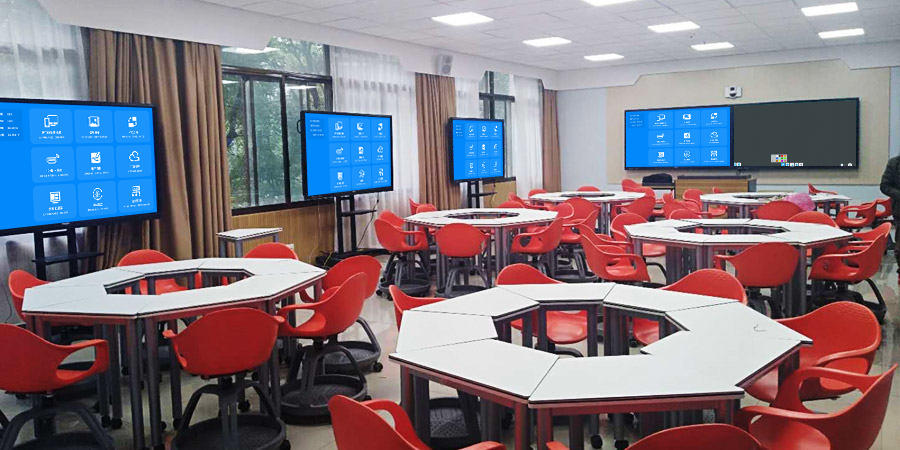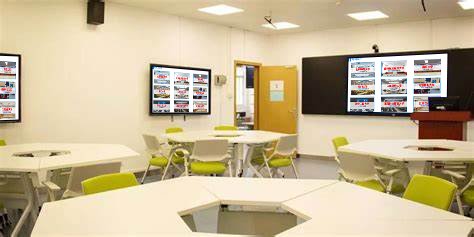Interactive Classroom: An Immersive Teaching and Collaboration Solution
The interactive classroom solution breaks away from the traditional one-way teaching model. Through multi-device collaboration, a variety of interactive functions, and a smart teaching system, it creates an integrated “teach–learn–assess–manage” environment. It’s suitable for primary and secondary schools, university courses, and vocational training, making classes more engaging and teaching more efficient.
Full Device Collaboration, Building an Interactive Teaching Foundation
This solution is compatible with teacher devices (Windows/macOS computers, Android/iOS tablets, smart phones), student devices (tablets, clickers, laptops), and teaching terminals (smart boards, laser projectors, electronic whiteboards, recording equipment). It enables seamless collaboration across all devices:
- Instant Connection: A teacher’s device can connect to a large teaching display in 2 seconds with wireless mirroring or a QR code, and student devices can join the interactive system by scanning a code, with no complex wiring required.
- Multi-Screen Sync: The large teaching display shows the core content, and student devices receive the courseware and exercises in sync. They can save them with one click for post-class review.
- Cross-Device Collaboration: A teacher can use a tablet to annotate and highlight content, and it will be synchronized to the large display in real time. Students can submit answers with a clicker or tablet, and the results are instantly fed back to the main display, creating a closed loop of teaching and learning.
Diverse Interactive Functions, Activating the Classroom
1. Precise Teaching Interaction
- Real-Time Quiz Feedback: It supports various question types, including multiple choice, true/false, subjective questions, and polls. After students answer instantly on their devices, the large display automatically generates a data report on the answers (correctness rate, distribution of wrong answers, class ranking). A teacher can then address common mistakes, avoiding a “full-class lecture.”
- Group Discussion Collaboration: You can quickly divide students into study groups. Each group has its own interactive space (shared whiteboard, file transfer). The group’s work can be mirrored to a public large display with a “group mirroring” function for inter-group peer review and teacher feedback, which is more intuitive.
- Random Questions: A teacher can initiate a “random roll call” or “raise your hand” question. Students can respond with their devices, which encourages everyone to participate and reduces “silent zones” in the classroom. It supports audio, text, and photo responses, adapting to different scenarios.
2. Immersive Teaching Experience
- Multimedia Integration: It supports synchronizing various materials like courseware, videos, animations, 3D models, and VR virtual scenes to the large display and student devices. When explaining the structure of a biological cell, a teacher can rotate a 3D model 360 degrees. When explaining physics, a teacher can play a dynamic lab animation, which makes abstract knowledge tangible.
- Smart Whiteboard Linkage: The large teaching display has a built-in electronic whiteboard function. It supports handwriting, drawing, an infinite canvas, and handwriting recognition (auto-converting formulas and text). A teacher can directly annotate key points on the courseware, and students can also go up to the board and use a stylus to write, making interaction as good as with a traditional blackboard.
- Live Object Display: A high-definition camera can be used to mirror books, lab equipment, and student homework to a large display, magnifying details for the whole class to see. Paired with an “annotation and explanation” function, a teacher can highlight key points in real time to make explanations more targeted.
3. Different Scenarios
- Basic Teaching: For primary and secondary school classrooms, it has built-in interactive modules for spelling, vocabulary memorization, and reading along with text. After a teacher assigns a task, students complete it on their devices, and the results are automatically graded and added to a “mistake notebook,” which reduces the teacher’s workload.
- University Labs: In a vocational school’s lab, a teacher’s hands-on process can be mirrored to the large display with a camera. Close-up details (like circuit welding and instrument operation) are clearly shown. Students can follow the steps, and the teacher can remotely check their progress on a tablet to give timely guidance.
- Outdoor Studies: In an environment with no network, it supports a direct device connection for mirroring. A teacher can use a phone or tablet to take photos and mirror the live view of plants, animals, or historical sites to a mobile large display, explaining key observations in real time. This tightly links knowledge with real-life objects.

Smart Management and Data Analysis, Empowering Teaching
More Efficient Teaching Management
- Classroom Control: A teacher can remotely control student devices (locking screens, pushing content, disabling irrelevant apps) to prevent distractions. It also supports “group control” to push different learning tasks to different groups, enabling tiered teaching.
- Resource Management: It has a built-in school resource library. A teacher can quickly retrieve courseware, exercises, and case studies, and they can also upload and categorize their own resources to make them easy to reuse.
- Attendance and Recording: When students scan a QR code to join the class, attendance is automatically recorded, and a report is generated. It also supports a full class recording, automatically synchronizing courseware, annotations, and interaction records. A “class replay” can be generated after class for students to review or for teachers to use for research.
Data to Improve Teaching
- Learning Analytics: It automatically records students’ quiz correctness, class participation, and homework completion. It generates individual and class learning reports to identify weak points, and a teacher can use this data to adjust their teaching focus.
- Teaching Evaluation: It records a teacher’s class interaction frequency, resource usage, and courseware annotations to provide an objective basis for teaching evaluations. It also supports a “class evaluation mode,” so other teachers can use their devices to give feedback, and a class evaluation report can be generated after class.
- Data Linkage: It can connect to the school’s academic and smart campus systems, and learning data can be synchronized to a student’s profile. Teaching data can be included in a teacher’s performance review, making teaching management digital.
Simple Deployment and Maintenance, Lowering the Barrier to Entry
- Flexible Deployment: It can be used for building a new smart classroom from scratch (including hardware and software) or upgrading an existing traditional classroom (just adding the interactive system module), with no need for large-scale demolition.
- Simple Operation: The interface is designed to match teaching habits, with clear function sections. A teacher can get the hang of it after just 1-2 training sessions. Students don’t have to install any apps and can start using it by scanning a QR code, so there’s no learning curve.
- Remote Maintenance: An administrator can monitor the operational status of devices in each classroom in real time (online status, signal strength, and battery level). It also supports remote on/off, firmware upgrades, and troubleshooting, with no need for a dedicated person on-site, which reduces management costs.
Whether for daily classroom teaching, public classes, practical training, or outdoor studies, this interactive classroom solution can precisely meet your needs, helping classrooms shift from “one-way teaching” to “two-way interaction” and boosting both teaching quality and learning outcomes.
